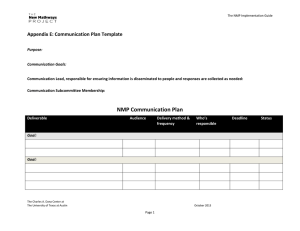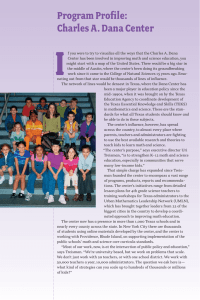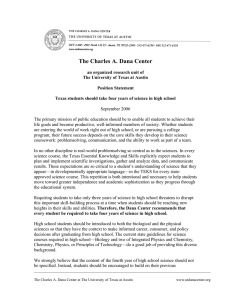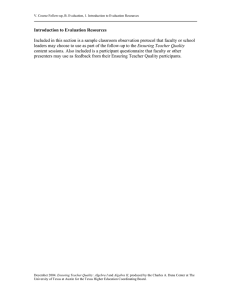Document 11677260
advertisement
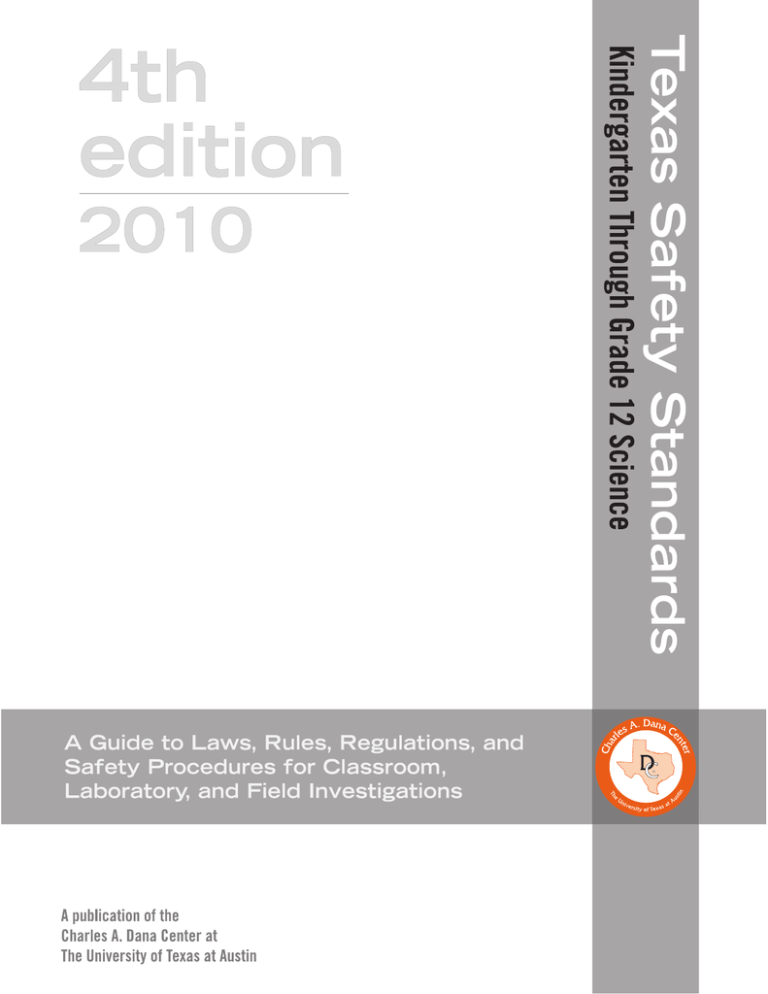
Copyright 2010, 2006, 2002, 2000, Charles A. Dana Center at The University of Texas at Austin This fourth edition of Texas Safety Standards: Kindergarten Through Grade 12 Science is copyright 2010. First edition published 2000; second edition, 2002; third edition 2006. Unless otherwise indicated, the materials found in this resource are the copyrighted property of the Charles A. Dana Center at The University of Texas at Austin (the University). No part of this resource shall be reproduced, stored in a retrieval system, or transmitted by any means— electronically, mechanically, or via photocopying, recording, or otherwise, including via methods yet to be invented—without express written permission from the University. We use all funds generated through use of our materials to further our nonprofit educational mission. Please send your permission requests or questions to us at this address: Charles A. Dana Center The University of Texas at Austin 1616 Guadalupe Street, Suite 3.206 Austin, TX 78701-1222 Fax: 512-232-1855 dana-txshop@utlists.utexas.edu www.utdanacenter.org The Charles A. Dana Center and The University of Texas at Austin, as well as the authors and editors, assume no liability for any loss or damage resulting from the use of this resource. We have made extensive efforts to ensure the accuracy of the information in this resource, to provide proper acknowledgement of original sources, and to otherwise comply with copyright law. If you find an error or you believe we have failed to provide proper acknowledgment, please contact us at dana-txshop@utlists.utexas.edu. About the development of this book The first and second editions of this book were funded in part by the Texas Education Agency and were based upon work supported by the National Science Foundation Cooperative Agreement #ESR-9712001, with additional funding support from the Charles A. Dana Center at The University of Texas at Austin. The substantial rewrites and updates that led to the third and fourth editions of this book were funded in full by the Charles A. Dana Center at the University of Texas at Austin. Any opinions, findings, conclusions, or recommendations expressed in this material are those of the author(s) and do not necessarily reflect the views of the National Science Foundation, the Texas Education Agency, or the University of Texas at Austin. Note: A number of images in this book are published with permission from their copyrightholders. The credits for all images are listed at the end of the Acknowledgments section of this front matter. July 2010 release. ISBN: 1-933765-20-8 ii Texas Safety Standards About the Charles A. Dana Center at The University of Texas at Austin The Dana Center works to raise student achievement in K–16 mathematics and science, especially for historically underserved populations. We do so by providing direct service to school districts and institutions of higher education; to local, state, and national education leaders; and to agencies, nonprofits, and professional organizations concerned with strengthening American mathematics and science education. The Center was founded in 1991 in the College of Natural Sciences at The University of Texas at Austin. Our original purpose—which continues in our work today—was to increase the diversity of students who successfully pursue careers in science, technology, engineering, and mathematics (STEM) fields. We carry out our work by supporting high standards and building system capacity; collaborating with key state and national organizations to address emerging issues; creating and delivering professional supports for educators and education leaders; and writing and publishing education resources, including student supports. Our staff of more than 60 researchers and education professionals has worked intensively with dozens of school systems in nearly 20 states and with 90 percent of Texas’s more than 1,000 school districts. As one of the College’s largest research units, the Dana Center works to further the university’s mission of achieving excellence in education, research, and public service. We are committed to ensuring that the accident of where a child attends school does not limit the academic opportunities he or she can pursue. For more information about the Dana Center and our programs and resources, see our homepage at www.utdanacenter.org. To access our resources (many of them free), please see our products index at www.utdanacenter.org/products. Our science toolkit is available at www.sciencetekstoolkit.org, and you can sign up for professional development around this Texas Safety Standards resource and other topics at www.utdanacenter.org/pd. The Charles A. Dana Center at The University of Texas at Austin iii Acknowledgments Unless otherwise noted, individuals listed were affiliated with the Dana Center at the time of their work on this book. Author and Project Manager James W. Collins, senior program coordinator, science Editorial and Production Team Editors Amy Dolejs and Steve Engler (lead editors and production editors, 4th edition) Rachel Jenkins (lead editor, 3rd edition; consulting editor, 4th edition) Karen Hoffman (lead editor, 1st and 2nd editions) Contributing Editor (1st edition) Barbara Foots, science education consultant, Houston, Texas Proofreaders (1st and 2nd editions) Brenda Nelson Kathy Park Senior Designer Phil Swann Safety Advisory and Review Committee (1st edition) Lawrence Andrews, Public Education & Information, State Fire Marshal’s Office Sandy Bankston. Instructor, The Rice School, Rice University Chris Castillo-Comer, Director of Science, Texas Education Agency David Fillman, Science and Health Coordinator, Galena Park Independent School District Jerry Garza, Engineer, Kent Consultant Engineers Steve Hall, Education Director, Texas Parks and Wildlife Mike Henry, Science Teacher, Kazen Middle School Kenneth W. Heydrick, Science Teacher, Westlake High School Byron E. Howell, South Central Regional Microscale Chemistry Center, Tyler Junior College Renee Krzypkowski, Health Science Technology, Texas A&M University–Commerce Paula McKinney, Texas Hazards Communication Branch, Texas Department of Health Kathy Park, Emergency Medical Technology, Lamar State College—Orange Irene Pickhardt, Assistant Director of Science, Texas Education Agency Mary Jane Schott, Director of Science, Texas Statewide Systemic Initiative Sandra S. West, Professor of Biology, Southwest Texas State University iv Texas Safety Standards Our special thanks to … We very much appreciate the contributions of the Texas Education Agency and others who provided resources, reviews, and content for the first two editions of this book. The first edition was produced by the Dana Center in cooperation with the Texas Education Agency’s Division of Curriculum and Professional Development. We substantially revised and updated the content in the third and fourth editions, which benefitted from review of the legal citations in Chapter 4 and updates to the laws in Appendix A conducted by Joseph B. Kulhavy, J.D. In addition, Chapter 5 in this fourth edition benefitted from a science medical review by Robert H. Emmick, Jr., M.D., Assistant Professor, Emergency Medicine, Paul L. Foster School of Medicine, Texas Tech University Health Sciences Center, El Paso, Texas. In addition, we thank the organizations listed below for continuing to graciously grant us permission to publish images from their collections. Isimet (www.isimet.com) Sargent-Welch (sargentwelch.com) ScholAR® Chemistry (www.scholarchemistry.com) VWR Education (www.vwreducation.com) WARD’s Natural Science (wardsci.com) Art Credits These credits name the source for each image in this book. Whenever the source listed is not Dana Center staff, the image used is either purchased clip art or stock art (e.g., images from Art Explosion) or used with permission from the copyright-holder (e.g., images from VWR Education). Figure 1.1, Dana Center staff; Figure 1.2, Dana Center staff; Figure 1.3, Dana Center staff; Figure 2.1, ScholAR® Chemistry; Figure 2.2, ScholAR® Chemistry; Figure 2.3, Dana Center staff; Figure 2.4, iStockphoto; Figure 3.1, Dana Center staff; Figure 3.2, WARD’s Natural Science; Figure 3.3, WARD’s Natural Science; Figure 3.4, WARD’s Natural Science; Figure 3.5, Sargent-Welch; Figure 3.6, iStockphoto; Figure 3.7, Sargent-Welch; Figure 3.8, Sargent-Welch; Figure 3.9, Dana Center staff; Figure 3.10, Sargent-Welch; Figure 3.11, WARD’s Natural Science; Figure 3.12, Dana Center staff; Figure 3.13, Sargent-Welch; Figure 3.14, Sargent-Welch; Figure 3.15, Sargent-Welch; Figure 3.16, VWR Education; Figure 3.17, Art Explosion; Figure 3.18, Sargent-Welch; Figure 3.19, Dana Center staff; Figure 3.20, Sargent-Welch; Figure 3.21, Isimet; Figure 3.22, Dana Center staff; Figure 3.23, iStockphoto; Figure 3.24, Sargent-Welch; Figure 3.25, ScholAR® Chemistry; Figure 3.26, ScholAR® Chemistry; Figure 3.27, Dana Center staff; Figure 3.28, Dana Center staff; Figure 4.1, Dana Center staff; Figure 5.1, Dana Center staff and iStockphoto; Figure 5.2, Art Explosion; Figure 5.3, iStockphoto; Figure 5.4, Jim Collins; Figure 5.5, Texas Poison Center Network; Figure 5.6, Oregon Poison Center; Figure 5.7, iStockphoto; Figure 5.8, iStockphoto; Figure 5.9, iStockphoto; Figure 6.1, Dana Center staff; Figure 6.2, Dana Center staff; Figure 6.3, ScholAR® Chemistry; Figure 6.4, Dana Center staff; Figure 6.5, Dana Center staff; Figure 6.6, WARD’s Natural Science; Figure 6.7, ScholAR® Chemistry; Figure 7.1, Dana Center staff The Charles A. Dana Center at The University of Texas at Austin v vi Texas Safety Standards What’s New in This Book...................................................................................xv Chapter 1: Safe Working and Learning Environments......................................... 1 What Research Indicates.......................................................................................... 2 Causes of Laboratory Accidents................................................................................. 3 Inadequate Facilities and Overcrowded Science Rooms...................................................... 3 What’s in This Book................................................................................................ 5 Chapter 2: Laboratory and Field Activities.......................................................... 7 Laboratory and Field Experiences in the State Standards. ............................................... 8 Kindergarten–Grade 1. ......................................................................................... 8 Grade 2. ........................................................................................................... 8 Grade 3. ........................................................................................................... 8 Grades 4–5........................................................................................................ 9 Grades 6–8........................................................................................................ 9 Biology. ............................................................................................................ 9 Chemistry.......................................................................................................... 9 Integrated Physics and Chemistry. ........................................................................... 10 Physics............................................................................................................ 11 The Charles A. Dana Center at The University of Texas at Austin vii Laboratory Management Techniques and Practices...................................................... 10 District-Level Administrator Responsibilities............................................................... 11 Department Chair or Lead Teacher Responsibilities....................................................... 11 Teacher Responsibilities........................................................................................ 12 Science Safety Guidelines for Students. ...................................................................... 16 Science Safety Student Responsibility Agreement........................................................... 18 Be Prepared for Accidents. .................................................................................... 19 Responding to an Injury. ...................................................................................... 21 Field Experiences and Activities............................................................................... 23 Planning a Field Experience................................................................................... 24 Preparing Students for a Field Experience................................................................... 27 Chapter 3: Safety Equipment and Supplies...................................................... 29 Personal Protective Equipment................................................................................ 29 Laboratory Aprons and Coats................................................................................ 30 Protective Eyewear.............................................................................................. 30 Protective Gloves................................................................................................ 33 Emergency Safety Equipment.................................................................................. 36 Eye/Face Wash Stations....................................................................................... 37 Safety Showers................................................................................................... 39 Handheld Drench Hoses....................................................................................... 41 First-Aid Kits. .................................................................................................. 42 Fire Blankets..................................................................................................... 43 Fire Extinguishers. ............................................................................................. 44 Emergency Utility Control..................................................................................... 46 Other Safety Equipment......................................................................................... 47 Fume Hoods..................................................................................................... 47 Storage Cabinets for Corrosives and Flammables .......................................................... 49 Safety Symbols and Safety Signage........................................................................... 52 Safety and Equipment Checklist Calendar.................................................................. 54 Facilities and Equipment Checklist........................................................................... 55 viii Texas Safety Standards Chapter 4: Laws, Rules, and Regulations......................................................... 57 Federal Law......................................................................................................... 58 29 United States Code (U.S.C.), Sections 651 et seq....................................................... 58 Regulation of Environmental Hazards in the Classroom.................................................. 60 20 U.S.C., Section 1412(a)(5)................................................................................ 60 State Laws, Rules, and Regulations........................................................................... 61 Texas Statutes...................................................................................................... 61 Texas Education Code—selected laws. ...................................................................... 61 Texas Health and Safety Code................................................................................ 64 Texas Civil Practice and Remedies Code.................................................................... 66 Safety and Tort Law. .......................................................................................... 66 Texas Administrative Code..................................................................................... 66 School Facilities Standards..................................................................................... 66 Code of Ethics................................................................................................... 70 Face and Eye Protection Standards........................................................................... 70 Office of the Attorney General, State of Texas............................................................. 71 Opinion No. DM-239......................................................................................... 71 Chapter 5: Hazard Concerns............................................................................. 73 Allergies. ............................................................................................................ 74 Latex Allergy.................................................................................................... 74 Peanut Allergy. ................................................................................................. 75 Biohazards.......................................................................................................... 75 Bacterial Hazards.............................................................................................. 75 Bloodborne Hazards............................................................................................ 76 Glassware Hazards................................................................................................ 77 Burns................................................................................................................. 78 Temperature Burns............................................................................................. 78 Chemical Burns................................................................................................. 81 Poisonous Plants and Fungi..................................................................................... 82 Animals in the Field. ............................................................................................. 86 Snakes............................................................................................................ 86 The Charles A. Dana Center at The University of Texas at Austin ix Insect and Arachnid Bites and Stings. ....................................................................... 87 Bees and Wasps................................................................................................. 87 Fire Ants......................................................................................................... 90 Blister Beetles.................................................................................................... 90 Caterpillars...................................................................................................... 90 Spiders............................................................................................................ 90 Scorpions......................................................................................................... 92 Live Animals in the Classroom................................................................................. 92 Guidelines for the Responsible Study of Animals........................................................... 92 Safety Concerns Related to Working with Animals........................................................ 93 Weather.............................................................................................................. 95 Heat.............................................................................................................. 95 Lightning......................................................................................................... 96 Flash Floods..................................................................................................... 96 Damaging Winds and Tornadoes............................................................................ 97 Chapter 6: Chemical Safety.............................................................................. 99 Developing a Chemical Hygiene Plan........................................................................ 99 Understanding Chemical Hazards.......................................................................... 100 National Fire Protection Association System.............................................................. 100 Hazard Materials Identification System................................................................... 101 Understanding Material Safety Data Sheets. ............................................................ 101 Section I: Product Identification (Name).................................................................. 106 Section II: Ingredients of Mixtures......................................................................... 106 Section III: Physical Data................................................................................... 106 Section IV: Fire and Explosion Hazard Data. ........................................................... 106 Section V: Health Hazard Data............................................................................ 107 Section VI: Reactivity Data................................................................................. 107 Section VII: Spill or Leak Procedures...................................................................... 107 Section VIII: Special Protection Information............................................................. 107 Section IX: Special Precautions............................................................................. 107 Understanding Chemical Labels............................................................................. 108 x Texas Safety Standards Chemical Storage................................................................................................ 109 Provide Appropriate Storage Space......................................................................... 109 Store Chemicals According to Compatible Groups. ...................................................... 110 Perform Maintenance and Inventory...................................................................... 110 Chemical Disposal.............................................................................................. 111 Limit the Amount of Chemicals Purchased. .............................................................. 111 Avoid Chemical Waste Errors. ............................................................................. 112 Chemical Spills................................................................................................... 112 Spill-Control Materials. ..................................................................................... 112 Transporting Chemicals....................................................................................... 113 Contact Lenses and Chemicals............................................................................... 114 Chapter 7: Safety Training and Professional Development.............................. 115 What Should Be Included and How Often?.............................................................. 116 Federal and State Safety Laws.............................................................................. 116 Science Safety Guidelines and Responsibilities............................................................ 117 Emergency Response System................................................................................. 118 Safety Equipment............................................................................................. 118 Personal Protective Equipment.............................................................................. 118 First Aid. ...................................................................................................... 118 Texas Hazard Communication Act........................................................................ 119 Bibliography.................................................................................................... 121 Appendix A: Laws, Rules, and Regulations .................................................... 125 National Science Education Standards Collaborative Inquiry Requires Adequate and Safe Space............................................... 128 Federal Law Occupational Safety and Health............................................................................ 129 Education of Individuals with Disabilities................................................................. 132 Equal Opportunity for Individuals with Disabilities..................................................... 133 General Safety Standards for Compressed Gas Storage and Use....................................... 134 Personal Protective Equipment.............................................................................. 135 The Charles A. Dana Center at The University of Texas at Austin xi Identification, Storage, Use, and Disposal of Hazardous Materials.................................... 141 Chemical Hygiene and Lab Rules.......................................................................... 143 Conditional Regulatory Exemption for Small Waste Producers........................................ 148 Texas Statutes Tort Claims ................................................................................................... 151 Equal Educational Services or Opportunities............................................................. 153 Immunity from Liability .................................................................................... 154 Alternative Settings for Behavior Management .......................................................... 156 Protective Eye Devices in Public Schools .................................................................. 160 Elimination of Architectural Barriers . .................................................................... 161 Hazardous Substances ....................................................................................... 171 Hazard Communication Act ............................................................................... 173 Texas Administrative Code, Title 19 Commissioner’s Rules Concerning School Facilities ...................................................... 188 Educators’ Code of Ethics ................................................................................... 201 Texas Administrative Code, Title 25 Guidelines for Selection and Use of Face and Eye Protection in Public Schools ...................... 203 Office of the Attorney General, State of Texas Opinion No. DM-239....................................................................................... 205 Appendix B: Professional Organization Position Statements .......................... 209 American College of Occupational and Environmental Medicine Use of Contact Lenses in an Industrial Environment ................................................... 210 Council of State Science Supervisors General Science Safety ....................................................................................... 215 National Association of Biology Teachers Role of Laboratory and Field Instruction in Biology Education ........................................ 218 The Use of Animals in Biology Education ................................................................ 222 National Science Teachers Association Safety and School Science Instruction . .................................................................... 225 Principles of Professionalism for Science Educators ...................................................... 227 Responsible Use of Live Animals and Dissection in the Science Classroom .......................... 230 Elementary School Science .................................................................................. 233 xii Texas Safety Standards The Integral Role of Laboratory Investigations in Science Instruction . ............................... 235 Students with Disabilities ................................................................................... 239 Liability of Science Educators for Laboratory Safety . ................................................... 241 Science Teachers Association of Texas Science Class Size and Laboratory Safety.................................................................. 246 Appendix C: Checklists . ................................................................................. 247 A Checklist for Science Field Investigations ............................................................... 248 Science Facility and Safety Equipment Checklist ......................................................... 249 Science Safety and Equipment Checklist (calendar) ..................................................... 253 Appendix D: Hazardous Chemical Lists .......................................................... 267 The Environmental Protection Agency’s Acutely Hazardous Chemicals List ........................ 269 The Occupational Safety and Health Administration (OSHA) List of Highly Hazardous Chemicals, Toxics, and Reactives............................................................. 272 Appendix E: Material Safety Data Sheet Glossary .......................................... 277 MSDS Example: Silver Nitrate ............................................................................ 278 Section I: Chemical Name .................................................................................. 280 Section II: Ingredients of Mixtures . ....................................................................... 281 Section III: Physical Data . ................................................................................. 282 Section IV: Fire and Explosion Hazard Data ............................................................ 283 Section V: Health Hazard Data ........................................................................... 284 Section VI: Reactivity Data ................................................................................ 285 Section VII: Spill or Leak Procedures ..................................................................... 286 Section VIII: Special Protection Information ............................................................. 287 Section IX: Special Precautions............................................................................. 288 Appendix F: State and Federal Agencies. ....................................................... 289 The Charles A. Dana Center at The University of Texas at Austin xiii What’s New in This Book The Dana Center is pleased to present the fourth edition of Texas Safety Standards: Kindergarten Through Grade 12 Science. The first three editions are widely used in Texas public schools as well as in other states as a tool for supporting students, teachers, and school administrators in understanding safety rules, regulations, and recommendations and establishing good safety procedures for science rooms. In this fourth edition, we have rearranged content from the third edition to improve flow and usability and have added a number of new images to enhance clarity. In addition, we updated the legal citations and laws in Chapter 4 and Appendix A (both titled Laws, Rules, and Regulations), and we added a new section on poisonous and nonpoisonous plants in Chapter 5, Hazard Concerns. In what follows, we provide a brief chapter-by-chapter overview of significant changes in this fourth edition. Additional research related to safety and the maximum number of students that should be allowed in a science class appears in Chapter 1, Safe Working and Learning Environments. New graphs show the reader the latest research data from a science safety survey the Dana Center conducted in Texas in 2009–2010. Chapter 2, Laboratory and Field Activities, has been expanded to include safety requirements mandated in the science Texas Essential Knowledge and Skills revised in 2009 (these TEKS are available for purchase or free download here: www.utdanacenter.org/sciencetoolkit/teks). In particular, student expectation (1)(A) in the 2009 revised elementary and middle school science TEKS requires not only that students “demonstrate safe practices” during classroom and outdoor investigations, but that students are to do so as described or outlined “in the Texas Safety Standards,” including wearing safety goggles, washing hands, and using materials appropriately. Further, the 2009 science TEKS note that districts are “encouraged to facilitate classroom and outdoor investigations” for at least 80% of instructional time in Kindergarten and Grade 1, 60% in Grades 2 and 3, and 50% in Grades 4 and 5. In middle school and high school, Knowledge and Skills statement (1) notes that the student is to conduct laboratory and field investigations for at least 40% of instructional time. Thus, in this edition of Texas Safety Standards, we have defined field experiences more broadly and have added new Student Science Safety Responsibilities and a Science Safety Student Responsibility Agreement as alternatives to the standard safety contracts that are used by many schools in Texas. We have added more images of personal protective equipment and safety equipment to Chapter 3, Safety Equipment and Supplies, so that school personnel can more easily distinguish between different types of personal protective equipment, such as safety goggles and safety glasses. In this chapter, we have also included images (taken from Dana Center–ScholAR® Chemistry products) of safety posters that show the proper use of various types of safety equipment. Users of the first three editions will find that the laws relating to safety in public schools have been updated in Chapter 4, Laws, Rules, and Regulations; full text of these laws appears in Appendix A. xiv Texas Safety Standards (Note that the law is constantly changing; the legal overview in Chapter 4 and laws excerpted in Appendix A are meant to provide a snapshot of the laws as they existed in Spring 2010. To access the most current laws, please consult with your district’s legal department.) In Chapter 5, Hazard Concerns, we address proper hand-washing and include references to new position statements from science professional organizations. A new section in this chapter highlights poisonous plants and fungi and lists poisonous and nonpoisonous plants that could be encountered on field excursions or brought into the class environment. The chapter also discusses animals that could be encountered in the field and includes images of some of the more dangerous ones. Introducing live animals in the classroom is always a concern; therefore, we provide additional information to help students remain safe as they come into contact with animals in the classroom and laboratory environment. Chapter 6, Chemical Safety, focuses on the Texas Hazard Communication Act and the need for Texas districts/schools to develop a chemical hygiene plan. In this section, we have expanded explanations about storing chemicals in compatible families and incorporated additional information about proper disposal of chemicals. This section also discusses spill-control materials that should be used in public schools (and includes some images of materials that can be used). Many questions arise concerning whether students should be allowed to wear contact lenses during laboratory investigations when chemicals are used. To address that question, we include a position statement by the American College of Occupational and Environmental Medicine that may help districts develop policies about the wearing of contact lenses in science rooms. Chapter 7, Safety Training and Professional Development, includes a table to help school districts figure out who should receive professional development and training and on what topics. In this edition, this chapter provides a more complete list of topics for safety training and professional development. Appendix A, Laws, Rules, and Regulations, contains up-to-date text of selected laws that govern science safety in Texas schools. Appendix B, Professional Organization Position Statements, reflects changes made by science professional organizations to their positions on important issues in science education, such as the maximum number of students that a teacher should have in science classes. Appendix C, Checklists, includes a checklist and safety calendar forms for teachers and administrators to use as examples in developing their own. In addition, readers will find the Dana Center’s Safety and Equipment Checklist Calendar to help them with routine science safety checks at their schools. Appendix D, Hazardous Chemical Lists, provides tables of hazardous chemicals that are not recommended for use in public schools. It is the same version that appeared in the 2006 edition of Texas Safety Standards. A glossary of terms commonly found on a Material Safety Data Sheet appears in Appendix E, Material Safety Data Sheet Glossary. Each page contains a section of an MSDS with the definition of the terms used in the section appearing below it. An updated listing of agencies that science teachers may find helpful appears in Appendix F, State and Federal Agencies. Current contact information is given with each listing. The Charles A. Dana Center at The University of Texas at Austin xv
